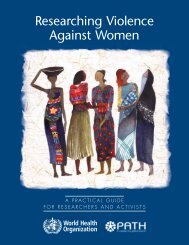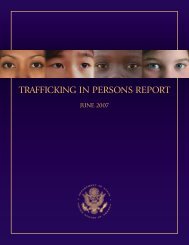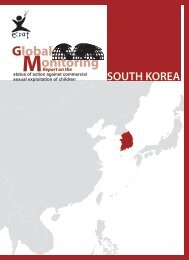Download PDF - Violence Against Children - East Asia and the ...
Download PDF - Violence Against Children - East Asia and the ...
Download PDF - Violence Against Children - East Asia and the ...
Create successful ePaper yourself
Turn your PDF publications into a flip-book with our unique Google optimized e-Paper software.
The Philippines<br />
• children who are affected by domestic<br />
violence in project areas<br />
• children affected by armed conflict in<br />
specific areas<br />
• a relatively high number of children in<br />
communities having experienced rape<br />
• young women <strong>and</strong> men from <strong>the</strong> provinces<br />
seeking work as domestic staff in urban<br />
areas <strong>and</strong> being tricked into situations of<br />
abuse or exploitation, <strong>and</strong><br />
• weak government policy <strong>and</strong> practice on<br />
issues such as substance abuse <strong>and</strong><br />
combating child labour.<br />
<strong>Children</strong> have also provided significant<br />
fur<strong>the</strong>r input as to <strong>the</strong> concerns <strong>the</strong>y believed<br />
should be given priority (see under Impact<br />
of <strong>the</strong> project section).<br />
An integrated approach<br />
World Vision aims for lasting change in <strong>the</strong><br />
lives of children, <strong>the</strong>ir families <strong>and</strong><br />
communities. We want to influence<br />
policymakers <strong>and</strong> those in power to have<br />
specific programs/budget for children, <strong>and</strong><br />
streng<strong>the</strong>n local/national measures to ensure<br />
that children are protected <strong>and</strong> represented.<br />
Partners in this process<br />
Engaging local government at a “meso” level<br />
on child protection is one area where some<br />
provinces of <strong>the</strong> Philippines are breaking new<br />
ground. A significant initiative in Bohol is a<br />
provincial children’s code, which sets <strong>and</strong><br />
monitors st<strong>and</strong>ards of a social safety net for<br />
children. The formation of <strong>the</strong> Bohol<br />
<strong>Children</strong>’s Code has been a local initiative<br />
linked to a national Exp<strong>and</strong>ing <strong>Children</strong>’s<br />
Participation in Social Reform (ECPSR)<br />
program. ECPSR’s long-term goal is enhanced<br />
children’s participation in local governance,<br />
<strong>and</strong> it has national-level government<br />
involvement as well as NGO implementation.<br />
NGO partners in <strong>the</strong> national program<br />
include PLAN International; World Vision<br />
Development Foundation; Education,<br />
Research <strong>and</strong> Development Assistance<br />
Foundation; <strong>and</strong> Christian <strong>Children</strong>’s Fund.<br />
The Bohol <strong>Children</strong>’s Code is one example<br />
where an operational framework for child<br />
participation links with public awareness,<br />
advocacy <strong>and</strong> coalition-building. The result is<br />
policy <strong>and</strong> programs that support children,<br />
families <strong>and</strong> build community, all in areas<br />
prioritised in <strong>the</strong> CAN study. 2 One difference<br />
in <strong>the</strong> Philippines compared to some o<strong>the</strong>r<br />
countries of <strong>the</strong> present study is that<br />
decentralising some government functions<br />
gives district authorities opportunity to<br />
collect tax <strong>and</strong> respond to local priorities. In<br />
this case, a budget for children’s activities has<br />
been established <strong>and</strong> lobbying has resulted in<br />
a child protection focus with great potential. 3<br />
UNICEF supported <strong>the</strong> provincial authority,<br />
working with a steering group, to run<br />
consultative seminars. This example is a key<br />
step in localising international protection<br />
provisions expressed in <strong>the</strong> Convention on <strong>the</strong><br />
Rights of <strong>the</strong> Child (CRC). World Vision has<br />
opportunity to monitor <strong>the</strong> implementation<br />
of <strong>the</strong> code <strong>and</strong> learn from <strong>the</strong> process. It<br />
may be possible for NGOs such as World<br />
Vision to engage local governments in moving<br />
to have similar legislation in regions where<br />
governance is at such a point that<br />
development of local legislation is possible.<br />
<strong>Children</strong> as partners at community level<br />
Community organisations <strong>and</strong> supported<br />
children’s groups (called <strong>Children</strong>’s<br />
Associations) are effective avenues to lobby<br />
for <strong>the</strong> full implementation of <strong>the</strong> existing<br />
children’s agenda, <strong>and</strong> to monitor application<br />
of national commitments locally.<br />
<strong>Children</strong>’s Associations aim to build <strong>the</strong><br />
self-esteem of children <strong>and</strong> are a principal<br />
vehicle for engaging <strong>the</strong> community on child<br />
protection. A significant support to <strong>the</strong><br />
recognition of child participation is in <strong>the</strong><br />
form of National Government approval:<br />
Executive Order 421, 4 issued in June 1997,<br />
establishes <strong>the</strong> legal identity of <strong>Children</strong>’s<br />
Associations <strong>and</strong> encourages <strong>the</strong>ir support<br />
from local authorities. At <strong>the</strong> time of <strong>the</strong><br />
study, <strong>the</strong>re were 29 associations, with a<br />
membership of 1,165 children.<br />
2<br />
3<br />
Dorning, K, Crying Out: <strong>Children</strong> <strong>and</strong> communities speak on abuse <strong>and</strong> neglect, World Vision International, 2002 (http://www.wvi.org/imagine/can.htm)<br />
Implementation H<strong>and</strong>book for <strong>the</strong> Convention on <strong>the</strong> Rights of <strong>the</strong> Child, UNICEF, 1998<br />
4 Executive Order No. 421 (“Fur<strong>the</strong>r amending Executive Order no. 203 dated 27 September 1994, as amended by Executive Order no. 356, dated 12 July<br />
1996”) can be viewed on-line at: http://www.childprotection.org.ph/databases/docs/eo421.doc<br />
58

















